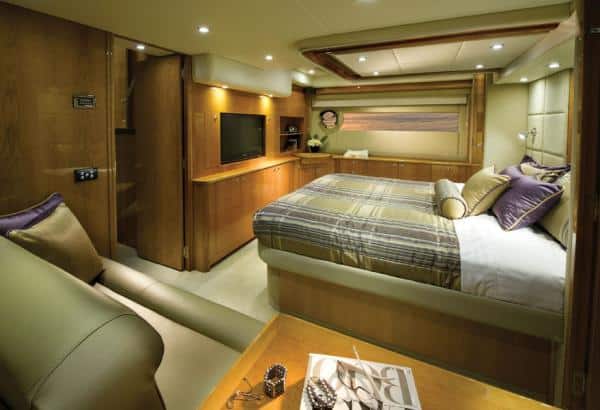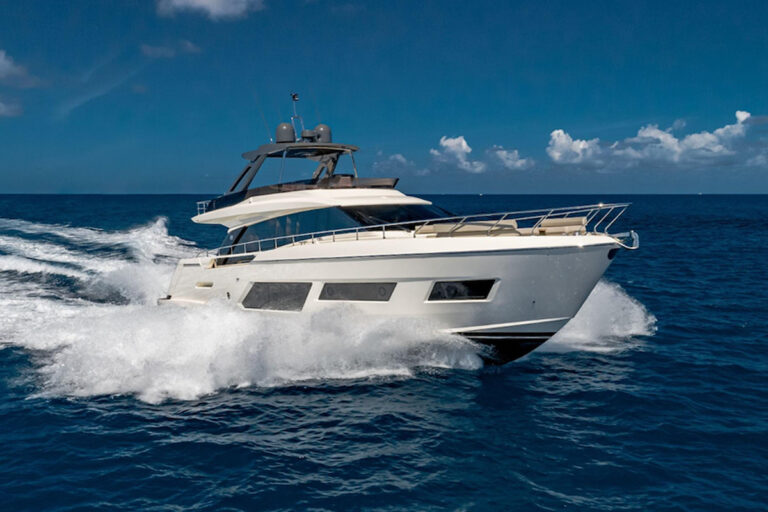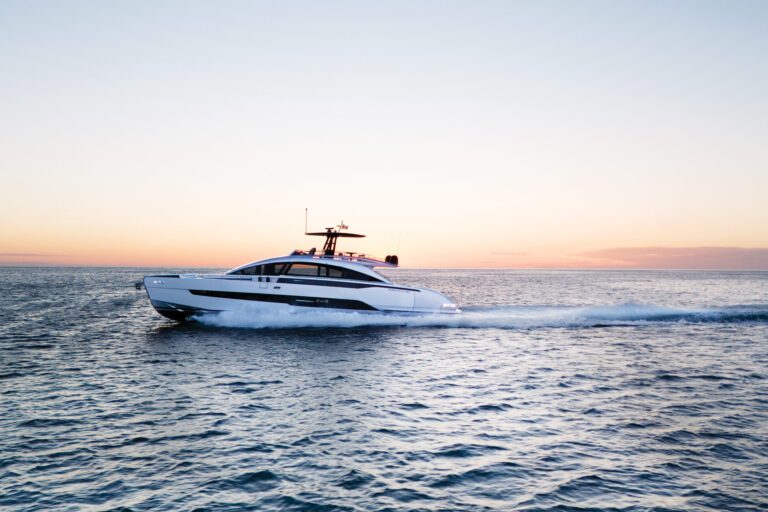
Riviera 53
“I love the space.”
“Look how open this is.”
“This is a big boat.”
“Wow!”
The comments flow like a river through the day. The more time I spend aboard the Riviera 53 during the Sanctuary Cove Boat Show in Australia, the more spontaneous remarks I overhear as the public passes through the boat. Simply hanging back and watching the large crowd is a great way to collect consumer feedback on the latest model from the Australian builder.
Generally, the conversation from the boat show attendees focuses on the tremendous use of space, the big cockpit and the seamless transition between the salon and galley. I make my way to the lower deck, where a crowd bottlenecks at the entrance of the huge master stateroom, absorbing the functionality and details of the full-beam suite.

“This is not a 53-footer. This is a much bigger boat” is the recurring theme.
Introduced in May, the Riviera 53 represents the latest in an aggressive new-model campaign by Riviera. It reveals management’s effort to extrapolate the builder’s ethos and to hyperfocus on how people truly use their boats. Past sins of trying to be a sport-fisher-centric builder, especially in North America, are washed away — a wise approach to boatbuilding.
“The bulk of Riviera owners really cruise,” says Stephen Milne, director of brand and communications for Riviera. And so does Milne, which is why he recognizes the importance of such details as an elevated cockpit settee on the mezzanine, or the full-service wet bar with a Kenyon barbecue across the transom. Checking the progress of dinner on the grill is a simple matter of turning on the LED lights on the bar’s lid to illuminate the cooking surface — one of many thoughtful details aboard.
The opening after window between the galley and cockpit is now a popular feature with a variety of builders.
However, on the 53 the galley is three steps above the cockpit. This provides a commanding view of all the activity, creating a truly unique space. When the canvas extension is stretched across the cockpit, the marrying of the two areas rivals that of many shore-based great rooms. I like the fact that the after window opens manually rather than with an electrical mechanism that presents one more item to service, but I would suggest installing a safety line on the bottom edge to control the opening of this heavy piece of hardware. The gas-assist struts are so powerful that there is a lot of spring waiting to be released when you open the handles.
The galley holds more cold stowage than some small restaurants, with two drawer freezers, two drawer refrigerators, and an ice maker opposite the galley. Additional amenities include a big sink, an electric cooktop and loads of counter space. Two cooks can easily operate in this galley.
Two huge settees — one serving as part of the dinette — fill both sides of the salon. This area, the enclosed bridge and the cockpit keep guests from having to compete for space. A single windshield mullion aids in visually opening up the room by creating an unobstructed line of sight for all.

“I bet it’s going to be too top-heavy,” the never-ending chatter continues. A few skeptics ask if the massive enclosed bridge will adversely affect the 53’s handling. OK, I admit I’m curious as well, and eagerly anticipate running the boat in the choppy Coral Sea off Surfers Paradise.
Sorry to disappoint the doom-and-gloom crowd, but this Australian honey handles very well. Turning is tight and responsive. We drive the 53 in a four-foot beam sea, experiencing no adverse affects from the additional superstructure, which is kept light during the build process.
The three 435 horsepower Volvo IPS diesels propel the 53 to a top speed of 29.5 knots at 3600 rpm while burning a total of 66 gallons per hour. I pull the throttle back to 3000 rpm, and she settles in at 21.4 knots, burning a total of 43 gallons per hour for all three engines. This translates to a range of about 400 miles at 21 knots (based on a 10 percent reserve and no generator use).
Riviera also offers engine packages from Caterpillar and MTU, coupled with pod-drives. This setup relies on two engines versus the three-engine configuration of our test boat. (I’d like to run a 53 with one of these options to compare against the fuel burn of our test boat.)
This is the first Riviera entirely laid up with resin infusion. The process sucks out excess resin during lamination, resulting in a lighter and stronger hull — and a better working environment in the glass shop. Quality control is also improved by eliminating the excess air that can cause voids, weakening the structure.
The helm features two Pompanette chairs, and the small settee to starboard provides a comfortable perch from which to kick back while under way. The tilt wheel is flanked by the joystick, engine controls and two Raymarine E140 touchscreen multifunction displays. Additional refrigeration, a sink and stowage line the starboard portion of the enclosed bridge. It’s important to note that with the sunroof and side windows opened, and the Isinglass rolled up, the outdoors flows right in. A doorway closes off the stairs to the salon, allowing another stateroom or teenage hideaway. An optional arrangement places the helm abaft the settee, although I would question the forward line of sight.
“This is also our first boat designed from the hull up around pod propulsion,” said Milne. By placing the three engines under the cockpit sole, a huge amidships stowage area is created forward of the engine room. At the tallest point there is crouching headroom of 5 feet, 6 inches. The space can absorb all the stores required for long-distance cruising, plus there’s additional freezer space, stowage for every tool you’ll ever need and room for a few folding bikes. A crew-quarters option is available as well.

Another benefit of placing the engines under the cockpit is room for that cavernous full-beam master. An island berth is surrounded by high-gloss cherry cabinetry, windows on both sides and a plush settee to port.
In the master head, backlit panels in the shower, high-end faucets and rainfall shower head will make the optional Sea Recovery watermaker a must. Two comfortable guest staterooms and a second head complete the lower deck accommodations.
The 10.5-foot (3.2 meter) tender is carried on the bow, accessed via wide side decks. Thirty-inch safety rails and plenty of grab rails will keep crew safe and secure.
If Riviera wants to let the world know that it is focused on building serious cruisers, there may be no better spokesperson than the 53. The North American debut will be at this Fort Lauderdale International Boat Show. You too may find yourself saying “Wow.”
LOA: 59’8″
BEAM: 16’10”
DRAFT: 4’10”
DISPL.: 49,160 lb.
FUEL: 925 gal.
WATER: 198 gal.
ENGINE OPTIONS: 2 x 700 hp Volvo IPS 900 diesels, 2 x 900 hp Volvo IPS 1200 diesels,
3 x 600 hp QSC Cummins Zeus drives, 2 x 835 hp MTU ZF 4000 pod-drives
ENGINES TESTED: 3 x 435 hp Volvo IPS 600 diesels
BASE PRICE: $1,683,700
PRICE AS TESTED: $1,856,886
Test Conditions: Speeds were measured by GPS in the Coral Sea, Australia, with three-foot seas and 10 to 15 knots of wind, full fuel, full water and six people on board. Fuel consumption was calculated by the electronic engine-monitoring system. Sound levels were measured at the helm.
RPM Knots GPH dB(A)
900 4.5 2.2 66
1200 7.4 3.0 62
1500 9.0 7.8 57
1800 10.3 12.0 61
2100 11.5 19.0 61
2400 13.9 26.0 61
2700 17.9 34.0 61
3000 21.4 43.0 65
3300 25.1 53.0 66
3600 29.5 66.0 68
_Riviera Yachts of the Americas, 772-403-1060; www.rivierayachtsinc.com
_





